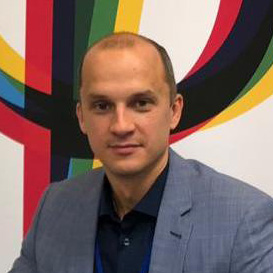
Federal Scientific Center for Psychological and Interdisciplinary Research, Moscow, Russia
Internal affairs director of the RPS
Lomonosov Moscow State University
Moscow, Russia
-
Analysis of Eye and Head Tracking Movements During a Puck-Hitting Task in Ice Hockey Players, Compared to Wrestlers and ControlsPolikanova, I.S.; Sabaev, D.D.; Bulaeva, N.I.; Panfilova, E.A.; Leonov, S.V.; Bugriy, G.S.; Bespalov, B.I.; Kruchinina, A.P.PDF HTML6005“ CITE
Polikanova, I.S., Sabaev, D.D., Bulaeva, N.I., Panfilova, E.A., Leonov, S.V., Bugriy, G.S., Bespalov, B.I., Kruchinina, A.P., (2024). Analysis of Eye and Head Tracking Movements During a Puck-Hitting Task in Ice Hockey Players, Compared to Wrestlers and Controls, Psychology in Russia: State of the Art, 17(3), 63–80. DOI: 10.11621/pir.2024.0305
copied
-
Background. The study of eye-movement strategies of athletes of various disciplines and skill levels is highly significant for sports psychology, since the results can be used in training to improve performance. Such studies are extremely scarce for ice hockey.
Objective. To determine successful eye-movement strategies for ice hockey players compared to wrestlers and controls (non-athletes) during puck-hitting tasks of various degrees of difficulty, using virtual reality.
Design. The study involved 31 participants (male), including 13 ice hockey players (age 20 ± 2.5), 9 wrestlers (age 19 ± 1.9), and 9 controls (age 19 ± 1.3). We used a pre-developed VR-PACE technology that simulates an ice rink in virtual reality (VR). The task was to hit pucks. VR was presented via the HTC Vive Pro Eye with a built-in eye tracker (100 Hz). We analyzed the parameter that reflected the share of puck presence in one of selected retina areas (0–5°, 5–10°, 10–15°, 15–25°, 25–35°) of the left and right eyes and the head.
Results. Ice hockey players exhibited longer puck-tracking using both the near periphery (5–15°) and central retinal area (0–5°). Puck speed had minimal impact on eye-movement strategies, and the visual focus on these areas remained consistent regardless of task type. For both wrestlers and controls, visual fixations in the central retinal area increased when tracking the puck without a motor response, likely leading to higher energy consumption and sensory fatigue.
Conclusion. The optimal eye-movement strategy involves parafoveal tracking in the near periphery (5–15°) and partial foveal tracking (0–5°), allowing for better object information retention and efficient puck trajectory tracking with reduced energy expenditure.
DOI: 10.11621/pir.2024.0305
Keywords: hockey/ virtual reality/ eye movements/ eye tracking/ eye-movement strategies
-
-
Characteristics of Silent Counting in Synchronized Swimmers
-
This article describes the temporal characteristics of silent counting as used during a competition by the Russian youth team of synchronized swimmers. The athletes listened to the music that accompanied their performance at the competition. Diff erent indices of silent counting were defi ned, such as the beginning and cessation of diff erent periods of counting, counting frequency, the stability of the temporal structure of silent counting, the degree of synchronization of silent counting at diff erent moments during the sports program. We studied the relationship of these characteristics of counting with expert estimates of the athletes’ sense of tempo, coordination of movements, and choreographic abilities.
DOI: 10.11621/pir.2012.0031
Keywords: synchronized swimming, synchronicity of movements, silent counting, regulation of motor activity
-
-
The Possibility of Using Sign and Symbolic Tools in the Development of Motor Skills by Beginning Soccer Players
-
This article analyzes the use of iconic and symbolic tools by young athletes in the development of concrete motor skills. The study involved 22 young athletes, aged 5–6 years, attending a soccer school in Moscow, Russia. The methodological procedure included using specifi cally designed mini-movies, which were short video clips employing different sign and symbolic tools for mastering alternate dribbling using the inner and outer side of the foot and the subsequent kick of the ball toward the net. The results showed the eff ectiveness of these tools when working with young soccer players. Those athletes who used metaphors as one of the tools for mastering motor skills exhibited better movement development than did the athletes who used sign tools.
DOI: 10.11621/pir.2012.0030
Keywords: sport, sport psychology, motor skill, sign, symbol, metaphor, image
-
-
Methodological Foundations of Military Psychology and Psychological Security
-
The article is devoted to the history of development of military psychology from psychological and philosophical positions. The transition stage in development of military psychology from classical to postclassical type of rationality is focused. Analysis of combat activity as self-regulation system is presented. The latest technologies in solving key problems of military science are discussed.
DOI: 10.11621/pir.2011.0004
Keywords: military psychology, psychological security, history of psychology
-
-
Cognitive Aspects of Athlete Activity
-
Article is devoted to the issues of symbolic mediation and diagnostic of time perception in sport. Distinction between iconic and symbolic mediation is discussed. Evidences of effective implementation of symbolic mediation in sport are examined. Means of optimization of sportsmen and sportswomen training by the instrumentality of symbol are considered. The results of time perception diagnostic of Russian synchronized swimmers are described. It was shown that sportswomen are greatly varied in accuracy and stability of reproduction of long (2–5 sec) and estimation of short (less than 250 ms) time intervals, which were filled with different contents – ticks of metronome, persistent sound, pressuring the button and etc. The improvement of individual characteristics of time perception is an important psychological resource of sports achievements increase.
DOI: 10.11621/pir.2009.0030
Keywords: sport psychology, symbol, icon, image, situation of uncertainty, synchronized swimming, time perception.
-









